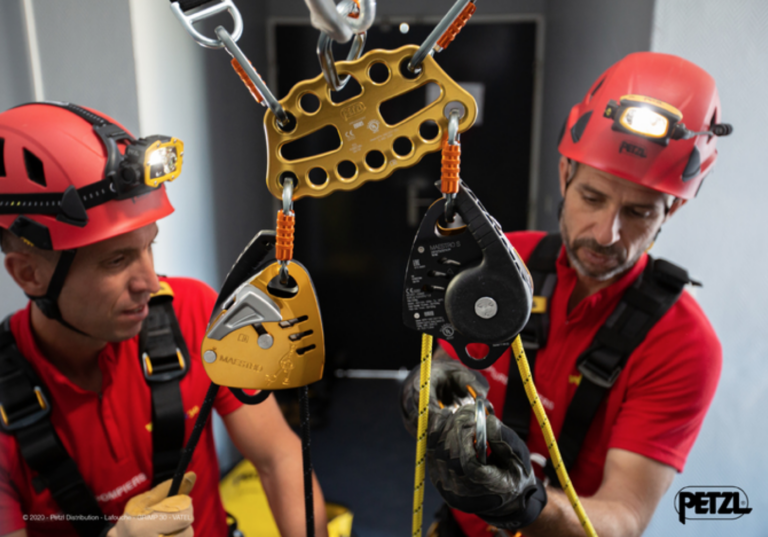Technical Rescue Rigging Setup Guide
In the world of technical rescue, a well-constructed rigging setup can mean the difference between a successful operation and a risky situation. Every piece of equipment plays a role, working together in harmony to ensure stability, control, and safety. Let’s break down the essential components of this setup, using our featured image to illustrate how each part functions within a larger, unified system.
Breaking Down the Rigging Setup
The image captures two rescue technicians working with a precision that reflects their training and the importance of every detail. It’s a glimpse into their world—a world where each piece of equipment has a specific role, and no component is chosen by accident.
The Rigging Plate – Building a Solid Foundation
At the center of this setup is the rigging plate, the unsung hero of rescue operations. It’s the hub where all other elements connect, designed to distribute weight and stabilize multiple attachment points. The plate allows for organized rigging, helping technicians manage complex loads and multiple directions safely.
In this scene, the rigging plate provides a foundation for pulleys and carabiners, supporting a web of connections that keeps the entire system secure. This compact yet robust component holds everything in place, turning chaos into order and ensuring that the operation remains steady under pressure.
Pulleys – Reducing Friction and Managing Load
Notice the two pulleys, the Petzl MAESTRO S and the I’D, each chosen with intent. These pulleys aren’t just there to hold the rope; they are precision tools for moving and controlling loads. The MAESTRO S, with its integrated braking system, is ideal for handling heavy loads with finesse, allowing the technicians to lower or raise objects smoothly and safely. Meanwhile, the I’D pulley adds an extra layer of control, offering a self-braking mechanism perfect for descent and belay.
Together, these pulleys transform potential friction points into fluid movement, allowing technicians to manage weight shifts and directional changes seamlessly. This isn’t just about lifting; it’s about the controlled, calculated movements essential in rescue situations where precision is key.
Carabiners – The Connectors Holding It All Together
Look closely, and you’ll see the locking carabiners, securing each piece of equipment to the rigging plate and keeping everything linked tightly. These small but mighty connectors are a technician’s lifeline, designed to lock safely and withstand significant stress. They are the unsung heroes that bind this intricate system, providing a secure, flexible way to connect pulleys, ropes, and plates without risking accidental disconnection.
In technical rescue, there’s no room for error. Each carabiner is chosen for its strength and reliability, and here, they ensure that every piece of equipment remains exactly where it’s needed.
Ropes – The Lifeline of the Setup
In the image, the ropes run through each pulley and carabiner, providing the primary means of movement and support. Rescue technicians typically use static ropes for these setups to reduce stretch, allowing for more stable and controlled maneuvers. In a high-stakes environment, the rope is the literal lifeline—selected and inspected to withstand immense pressure without fail.
The ropes connect everything, running smoothly through the pulleys to allow controlled lowering or hoisting, critical in rescue scenarios where the safety of both the rescuer and the person being rescued is paramount.
The Importance of High-Quality Gear in Technical Rescue
What this image ultimately reveals is that each component serves an essential role, and no part can be overlooked. Rigging plates, pulleys, carabiners, and ropes—all of these are designed to meet the rigorous demands of technical rescue. This equipment isn’t chosen for convenience but for its reliability under pressure. Brands like Petzl, seen here, have built a reputation for quality, ensuring that rescue teams can depend on their gear when it matters most.
Conclusion
The Technical Rescue Rigging Setup Guide you see in this image is more than a collection of tools; it’s a carefully crafted system, built with precision and purpose. Each piece works in harmony to create a stable, secure network that allows rescue technicians to do their work effectively and safely. By understanding how each component contributes to the whole, technicians and enthusiasts alike can appreciate the art and science of technical rescue.
Related Posts :
- The 13 Essential Components of Technical Rope Rescue
This article provides a comprehensive overview of critical elements in rope rescue operations, aligning well with your guide’s focus on essential rigging components. - Rope Rescue Highline Systems and Rigging Techniques
Delving into advanced rigging techniques, this piece offers insights into highline systems, which can add depth to discussions on complex rigging setups. - Anchor Overview for Rope Rescue Rigging
A detailed examination of anchor systems, this article complements sections of your guide that discuss the foundational aspects of rigging setups. - Dual Capability Two Tensioned Rope Systems (DC TTRS): Technical Rope Rescue Systems Overhaul
Exploring modern advancements in rope rescue systems, this article can provide readers with updated perspectives on rigging techniques. - A Quick Overview and Essential Checklists of Highline Systems
Offering practical checklists and overviews, this piece can serve as a valuable resource for readers seeking actionable information on highline rigging systems.









